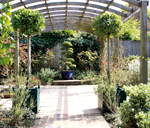Using your garden to sell your house
Arabella Youens looks at the types of garden which are attracting buyers to properties for sale


The Good Life vibe has swept through Britain in recent months: demand for allotments is, in some areas, higher than in the past 80 years, and sales of food seeds have overtaken flower seeds. This renewed interest in grow-your-own produce is made up of recessionary bites on everyone’s income, concern about what we’re ingesting, perhaps some romanticising by television programmes, and guilt about food miles: only 10% of the fruit we consume is grown in this country.
Gardens as the Daily Telegraph’s recent publishing of MPs’ expense claims shows can be a costly accessory. But agents believe they’re an essential investment for anyone looking to market their house. ‘There’s a huge interest in gardening among our clients,’ says Dawn Carritt of Jackson-Stops & Staff. ‘Houses with walled kitchen gardens that have been turned into orchards often prompt prospective buyers to say that they would convert them back into vegetable gardens.’
Country houses sell well in spring, often on account of their gardens. ‘This is the time of year when gardens come into their own, enchanting the senses and making would-be buyers reach for their cheque books,’ says Crispin Holborow of Savills.
However, Philip Procter of Humberts in York does caution: ‘I think the Good Life dream is overstated. People buy houses with every intention of growing their own vegetables, and the opportunity to do that is a big selling feature for a house. The reality is rather different by the time they’ve moved in but that doesn’t diminish the intention.’
Michael de Pelet of Knight Frank’s Sherborne office is a living, breathing Good Lifer. ‘I have everything: pigs, chickens, ducks and a vegetable garden. It’s lovely to have your own eggs and pick your own asparagus, but it’s hard work. Some people come to the country yearning to be able to do this, but they don’t always realise what’s involved.’ All agree, however, that a well-tended garden is fundamental to the successful sale of a country house. ‘Gardens and grounds are vital,’ believes Mr Procter. ‘I often prefer the gardens to the house and would be happier in a beautifully situated bungalow than a lovely house in a wasteland.’
Mr Procter is selling Normanby House, a pretty former rectory in North Yorkshire. ‘The approach to the house passes under a fine copper beech and the principal garden is flanked by clipped yew hedging. It’s very evocative and plugs into that rural idyll image. It could be the setting of a Miss Marple mystery: the house would be owned by a retired colonel from India.’
Given the potential impact, Miss Carritt believes that a bit of work on the garden can be quickly reflected in the price of the property. ‘If the garden of your property is a bit motley, a bit of work can certainly improve the value. The garden is very much the setting of the house, so think ahead when preparing to sell. Bulbs that flower in succession will provide colour for the spring; bedding plants, meanwhile, will work for autumn. Very few people want Gertrude Jekyll-style borders that require serious time, however, so beware of adding too much.’
Sign up for the Country Life Newsletter
Exquisite houses, the beauty of Nature, and how to get the most from your life, straight to your inbox.
The maintenance aspect of a garden is something that’s troubling more clients than ever in this economic climate. ‘Larger gardens, just like larger houses, are making people sit up and think,’ says Edward Hall of Strutt & Parker. ‘The condition of a property will make clients question how much they’ll need to spend on it, and the size of garden will prompt questions about the costs of upkeep.’
These days, the most popular type of garden is one that ‘provides a quiet area where you can eat outside, somewhere that will house a marquee for parties or weddings, and unfussy beds,’ adds Mr Hall. ‘Before, people bought the house first and then worried about the garden later, but today, it’s rather different.’
Mr Holborow agrees: ‘There is growing caution among buyers over the size of gardens and concomitant cost of upkeep. For this reason, they often prefer wildflower meadows to herbaceous borders. Small vegetable gardens are also popular, particularly if they’re ornamental in design and in raised beds to help reduce weeding.’
* For more properties like this every week, subscribe and save
-
 About time: The fastest and slowest moving housing markets revealed
About time: The fastest and slowest moving housing markets revealedNew research by Zoopla has shown where it's easy to sell and where it will take quite a while to find a buyer.
By Annabel Dixon Published
-
 Betty is the first dog to scale all of Scotland’s hundreds of mountains and hills
Betty is the first dog to scale all of Scotland’s hundreds of mountains and hillsFewer than 100 people have ever completed Betty's ‘full house’ of Scottish summits — and she was fuelled by more than 800 hard boiled eggs.
By Annunciata Elwes Published
